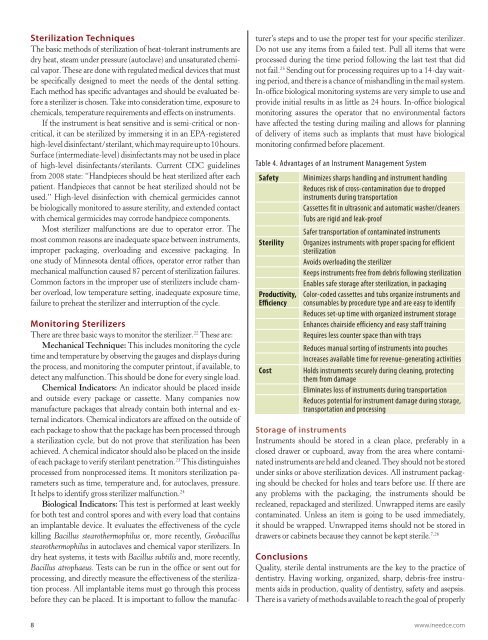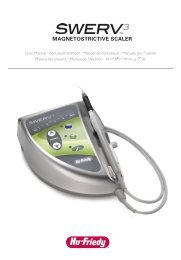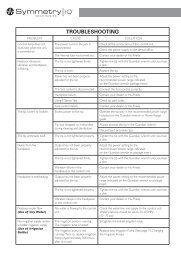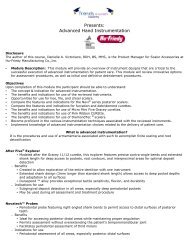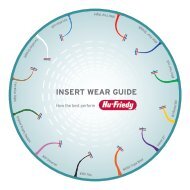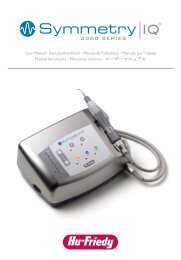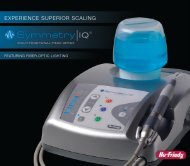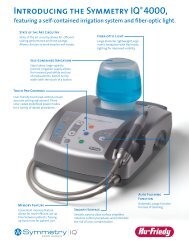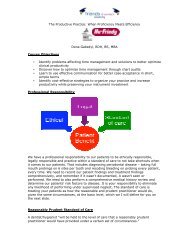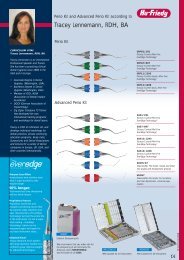Effective and Productive Instrument Processing - Friends of Hu-Friedy
Effective and Productive Instrument Processing - Friends of Hu-Friedy
Effective and Productive Instrument Processing - Friends of Hu-Friedy
You also want an ePaper? Increase the reach of your titles
YUMPU automatically turns print PDFs into web optimized ePapers that Google loves.
Sterilization Techniques<br />
The basic methods <strong>of</strong> sterilization <strong>of</strong> heat-tolerant instruments are<br />
dry heat, steam under pressure (autoclave) <strong>and</strong> unsaturated chemical<br />
vapor. These are done with regulated medical devices that must<br />
be specifically designed to meet the needs <strong>of</strong> the dental setting.<br />
Each method has specific advantages <strong>and</strong> should be evaluated before<br />
a sterilizer is chosen. Take into consideration time, exposure to<br />
chemicals, temperature requirements <strong>and</strong> effects on instruments.<br />
If the instrument is heat sensitive <strong>and</strong> is semi-critical or noncritical,<br />
it can be sterilized by immersing it in an EPA-registered<br />
high-level disinfectant/sterilant, which may require up to 10 hours.<br />
Surface (intermediate-level) disinfectants may not be used in place<br />
<strong>of</strong> high-level disinfectants/sterilants. Current CDC guidelines<br />
from 2008 state: “H<strong>and</strong>pieces should be heat sterilized after each<br />
patient. H<strong>and</strong>pieces that cannot be heat sterilized should not be<br />
used.” High-level disinfection with chemical germicides cannot<br />
be biologically monitored to assure sterility, <strong>and</strong> extended contact<br />
with chemical germicides may corrode h<strong>and</strong>piece components.<br />
Most sterilizer malfunctions are due to operator error. The<br />
most common reasons are inadequate space between instruments,<br />
improper packaging, overloading <strong>and</strong> excessive packaging. In<br />
one study <strong>of</strong> Minnesota dental <strong>of</strong>fices, operator error rather than<br />
mechanical malfunction caused 87 percent <strong>of</strong> sterilization failures.<br />
Common factors in the improper use <strong>of</strong> sterilizers include chamber<br />
overload, low temperature setting, inadequate exposure time,<br />
failure to preheat the sterilizer <strong>and</strong> interruption <strong>of</strong> the cycle.<br />
Monitoring Sterilizers<br />
There are three basic ways to monitor the sterilizer. 22 These are:<br />
Mechanical Technique: This includes monitoring the cycle<br />
time <strong>and</strong> temperature by observing the gauges <strong>and</strong> displays during<br />
the process, <strong>and</strong> monitoring the computer printout, if available, to<br />
detect any malfunction. This should be done for every single load.<br />
Chemical Indicators: An indicator should be placed inside<br />
<strong>and</strong> outside every package or cassette. Many companies now<br />
manufacture packages that already contain both internal <strong>and</strong> external<br />
indicators. Chemical indicators are affixed on the outside <strong>of</strong><br />
each package to show that the package has been processed through<br />
a sterilization cycle, but do not prove that sterilization has been<br />
achieved. A chemical indicator should also be placed on the inside<br />
<strong>of</strong> each package to verify sterilant penetration. 23 This distinguishes<br />
processed from nonprocessed items. It monitors sterilization parameters<br />
such as time, temperature <strong>and</strong>, for autoclaves, pressure.<br />
It helps to identify gross sterilizer malfunction. 24<br />
Biological Indicators: This test is performed at least weekly<br />
for both test <strong>and</strong> control spores <strong>and</strong> with every load that contains<br />
an implantable device. It evaluates the effectiveness <strong>of</strong> the cycle<br />
killing Bacillus stearothermophilus or, more recently, Geobacillus<br />
stearothermophilus in autoclaves <strong>and</strong> chemical vapor sterilizers. In<br />
dry heat systems, it tests with Bacillus subtilis <strong>and</strong>, more recently,<br />
Bacillus atrophaeus. Tests can be run in the <strong>of</strong>fice or sent out for<br />
processing, <strong>and</strong> directly measure the effectiveness <strong>of</strong> the sterilization<br />
process. All implantable items must go through this process<br />
before they can be placed. It is important to follow the manufac-<br />
turer’s steps <strong>and</strong> to use the proper test for your specific sterilizer.<br />
Do not use any items from a failed test. Pull all items that were<br />
processed during the time period following the last test that did<br />
not fail. 25 Sending out for processing requires up to a 14-day waiting<br />
period, <strong>and</strong> there is a chance <strong>of</strong> mish<strong>and</strong>ling in the mail system.<br />
In-<strong>of</strong>fice biological monitoring systems are very simple to use <strong>and</strong><br />
provide initial results in as little as 24 hours. In-<strong>of</strong>fice biological<br />
monitoring assures the operator that no environmental factors<br />
have affected the testing during mailing <strong>and</strong> allows for planning<br />
<strong>of</strong> delivery <strong>of</strong> items such as implants that must have biological<br />
monitoring confirmed before placement.<br />
Table 4. Advantages <strong>of</strong> an <strong>Instrument</strong> Management System<br />
Safety Minimizes sharps h<strong>and</strong>ling <strong>and</strong> instrument h<strong>and</strong>ling<br />
Reduces risk <strong>of</strong> cross-contamination due to dropped<br />
instruments during transportation<br />
Cassettes fit in ultrasonic <strong>and</strong> automatic washer/cleaners<br />
Tubs are rigid <strong>and</strong> leak-pro<strong>of</strong><br />
Safer transportation <strong>of</strong> contaminated instruments<br />
Sterility Organizes instruments with proper spacing for efficient<br />
sterilization<br />
Avoids overloading the sterilizer<br />
Keeps instruments free from debris following sterilization<br />
Enables safe storage after sterilization, in packaging<br />
Productivity,<br />
Efficiency<br />
Color-coded cassettes <strong>and</strong> tubs organize instruments <strong>and</strong><br />
consumables by procedure type <strong>and</strong> are easy to identify<br />
Reduces set-up time with organized instrument storage<br />
Enhances chairside efficiency <strong>and</strong> easy staff training<br />
Requires less counter space than with trays<br />
Reduces manual sorting <strong>of</strong> instruments into pouches<br />
Increases available time for revenue-generating activities<br />
Cost Holds instruments securely during cleaning, protecting<br />
them from damage<br />
Eliminates loss <strong>of</strong> instruments during transportation<br />
Reduces potential for instrument damage during storage,<br />
transportation <strong>and</strong> processing<br />
Storage <strong>of</strong> instruments<br />
<strong>Instrument</strong>s should be stored in a clean place, preferably in a<br />
closed drawer or cupboard, away from the area where contaminated<br />
instruments are held <strong>and</strong> cleaned. They should not be stored<br />
under sinks or above sterilization devices. All instrument packaging<br />
should be checked for holes <strong>and</strong> tears before use. If there are<br />
any problems with the packaging, the instruments should be<br />
recleaned, repackaged <strong>and</strong> sterilized. Unwrapped items are easily<br />
contaminated. Unless an item is going to be used immediately,<br />
it should be wrapped. Unwrapped items should not be stored in<br />
drawers or cabinets because they cannot be kept sterile. 7,26<br />
Conclusions<br />
Quality, sterile dental instruments are the key to the practice <strong>of</strong><br />
dentistry. Having working, organized, sharp, debris-free instruments<br />
aids in production, quality <strong>of</strong> dentistry, safety <strong>and</strong> asepsis.<br />
There is a variety <strong>of</strong> methods available to reach the goal <strong>of</strong> properly<br />
8 www.ineedce.com


